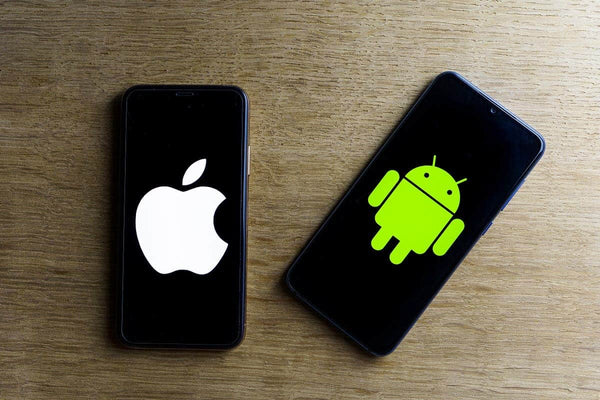One of the most important considerations you’ll have to make when picking a smartphone is deciding between an Android or iPhone. While both platforms have strong ecosystems, their user bases has varying priorities and tastes. We’ll compare the user experiences of the iPhone and Android in this blog, covering topics like customization, performance, interface design, and general usability to help you decide which operating system best suits your needs.

1. Interface Design and Usability
iPhone:
- Consistent Design: iOS is known for its consistent and intuitive design. The user interface is clean and straightforward, with a focus on simplicity and ease of navigation. Apps are arranged in a grid on the home screen, and the Control Center and Notification Center offer quick access to essential functions.
- Uniformity: All iPhone models run the same version of iOS (or close to it), ensuring a uniform experience across devices. This consistency means that user guides and support resources are broadly applicable, and app developers can create apps optimized for the same interface.
Android:
- Customization: Android excels in customization. Users can alter home screens with widgets, change app icons, and use third-party launchers to completely transform the look and feel of their devices. The Android interface allows for more personalization compared to iOS.
- Varied Experiences: Since Android is used by multiple manufacturers (Samsung, Google, OnePlus, etc.), the interface can vary significantly between devices. This means that while one device may offer a highly optimized experience, another might have a more fragmented approach.
2. Customization and Personalization
iPhone:
- Limited Customization: iOS offers limited customization options compared to Android. While you can rearrange apps and choose a wallpaper, iOS doesn’t support extensive modifications to the interface or the ability to change default apps for tasks like web browsing or messaging.
- Focus on Uniformity: Apple’s approach emphasizes a consistent user experience across its ecosystem, which may appeal to users who prefer a standardized and streamlined environment.
Android:
- Extensive Customization: Android allows users to tailor their devices extensively. You can customize home screens with widgets, choose from various third-party launchers, and even tweak system settings to suit personal preferences.
- Flexible Default Apps: Android users can set default apps for various functions, such as web browsing, email, and messaging, offering more control over their user experience.
3. Performance and Speed
iPhone:
- Optimized Hardware and Software: iOS is optimized to work seamlessly with Apple’s hardware. The tight integration between the operating system and the device’s hardware often results in smooth performance and efficient multitasking. iPhones are known for their speed and responsiveness, partly due to Apple’s custom-designed processors.
- Consistent Updates: Apple provides regular and timely updates to all supported iPhones simultaneously. This ensures that users receive the latest features and security patches promptly.
Android:
- Varied Performance: Performance can vary depending on the manufacturer and model. High-end Android devices generally offer performance on par with or exceeding that of iPhones, while budget devices may experience slower speeds and less fluid performance.
- Update Fragmentation: Android updates are less consistent due to the variety of manufacturers and devices. While Google’s Pixel phones receive updates promptly, other Android devices may experience delays in receiving the latest Android versions and security updates.
4. Ecosystem Integration
iPhone:
- Apple Ecosystem: iOS devices work seamlessly with other Apple products, such as Macs, iPads, and Apple Watches. Features like Handoff, AirDrop, and iCloud offer a cohesive experience for users invested in the Apple ecosystem. Integration between devices is a significant advantage for those who use multiple Apple products.
- App Quality: The App Store’s rigorous review process often results in high-quality apps that are well-optimized for iOS devices. This can enhance the overall user experience by ensuring that apps run smoothly and are free of major bugs.
Android:
- Diverse Ecosystem: Android integrates well with various Google services and products, such as Google Drive, Gmail, and Google Assistant. For users who rely on Google’s suite of tools, Android offers a seamless experience with these services.
- App Variety: The Google Play Store offers a vast array of apps, including those that are not available on the App Store. However, the quality and security of apps can vary, as the review process for the Play Store is less stringent.
5. Security and Privacy
iPhone:
- Security Features: iOS is known for its strong security and privacy features. Apple implements a strict app review process, and features like Face ID, Touch ID, and end-to-end encryption for iMessages and FaceTime calls enhance user security.
- Privacy Controls: Apple places a strong emphasis on user privacy, offering features like App Tracking Transparency, which allows users to control which apps can track their activity across other apps and websites.
Android:
- Security Measures: Android has made significant strides in security with regular updates and features like Google Play Protect. However, security can be inconsistent across different devices and manufacturers.
- Privacy Controls: Android provides robust privacy controls, including permission settings for individual apps and a dedicated privacy dashboard. Nonetheless, the level of privacy can vary based on the device manufacturer and Android version.
Conclusion
Your own objectives and tastes ultimately determine which iPhone or Android smartphone is best for you. An iPhone can be your best option if you prefer a dependable, simplified user experience with deep integration into a seamless ecosystem. On the other hand, an Android device can be more appropriate if you value personalization, adaptability, and a large selection of gadget possibilities.
The optimal option will rely on the features of the user experience that are most important to you, as each operating system has distinct advantages. You may make an informed choice that fits your needs and lifestyle by taking into account aspects like ecosystem integration, performance, customization possibilities, and interface design.
